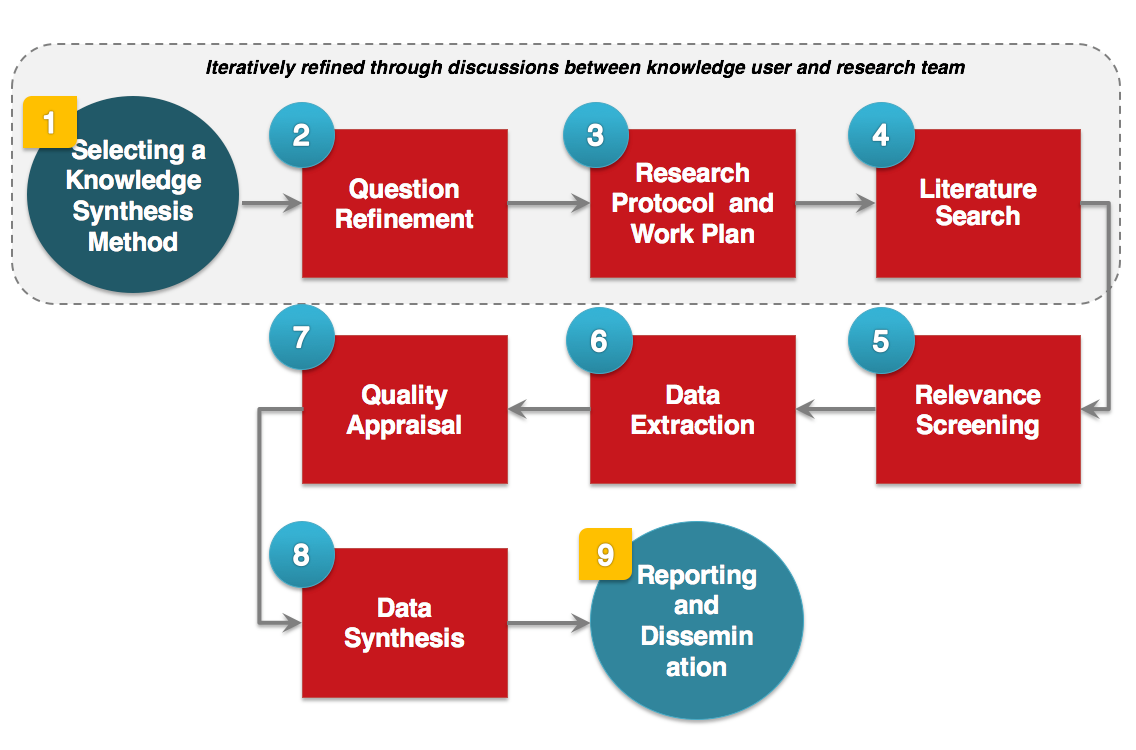
1. Selecting a Knowledge Synthesis Method
Research question is matched to an appropriate knowledge synthesis method in line with the purpose and objective of the research. A team to conduct the research is then set up including members with expertise in the knowledge synthesis method selected, clinical experts, knowledge users, and whenever possible, patients and research trainees/ graduate students.
2. Question Refinement
Research question is further refined and developed by clarifying the key elements (e.g., population(s), intervention(s), comparator(s) and outcomes) used to develop the research question. All outcomes that are of importance to our knowledge users are ranked and prioritized by patients and knowledge users using an online group ranking technique. Researchers and knowledge users work together to refine the question(s), as needed.
3. Research Protocol and Work Plan
A protocol for the planned knowledge synthesis is developed in consultation with all knowledge users and stakeholders. The protocol follows the reporting guideline, PRISMA-P1, and is peer-reviewed and registered with either PROSPERO or Open Science Framework. A summary of the registered protocol is also published under Our Projects. A work plan outlining the protocol, knowledge user engagement strategy, budget, and timeline is prepared. The work plan must be approved by the knowledge user before starting the review.
4. Literature Search
Multiple electronic libraries (e.g., MEDLINE, EMBASE) including those with specialized clinical areas (e.g., PsycINFO for mental health) are searched. An experienced librarian develops the search terms, which are peer-reviewed by another librarian using the Peer-Review of Electronic Search Strategies (PRESS)2. Grey literature are also considered.
5. Relevance Screening
A two-level screening process is used beginning with the screening of titles and abstracts of all records from the literature search. Potentially relevant full-texts articles are then screened for relevance. Each phase of screening begins with a pilot-test to make sure reviewers have sufficient agreement (>75%). Each title and abstract and full-text article is reviewed by two independent reviewers and any disagreements are resolved by discussion. Authors of primary studies are contacted when eligibility is unclear.
6. Data Extraction
A standardized form for data collection is developed and pilot-tested for agreement (>75%) between reviewers. Data from each article is collected by two independent reviewers. Disagreements between reviewers are resolved by discussion. If a study is missing important information, authors of primary studies are contacted.
7. Quality Appraisal
When applicable, each study is assessed for risk of bias using appropriate appraisal tool by two independent reviewers. This step also begins with a pilot-test to establish agreement between reviewers and any conflicts are resolved by discussion.
8. Data Synthesis
Both qualitative and quantitative analyses are considered depending on the knowledge synthesis method and the types of evidence included.
9. Reporting and Dissemination
Appropriate reporting guidelines available on the EQUATOR Network website for the specific knowledge synthesis is used to prepare the final report. Manuscripts are published in a peer-reviewed journal. If the journal is not open-access, a pre-publication version of the manuscript is posted on Our Projects tab. A 1-page research brief is prepared to provide a high-level summary of the research findings.